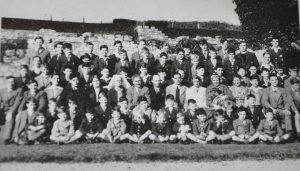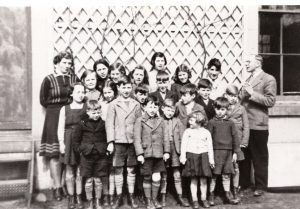Although many thousands of British evacuees were evacuated by steam train during the Second World War, others travelled to their new homes by steam ship. George Osborn recalled the excitement of his journey from Portsmouth to the Isle of Wight:
The great engines, powered by steam from the coal-fired boiler, slowly turned the two large paddles, thrashing and churning a watery roadway of bubbles in their wake. What a thrill, and how very different from the little paddle boats we had seen on the boating lake at Southsea in the summer months. When we arrived at Ryde Pier, my sister Brenda and I were no more than six miles from our home in Portsmouth, as the seagull flies, but we may as well have been a hundred miles away.
However, upon landing at Ryde the evacuees had to undergo further ordeals:
At the reception end, things weren’t quite so well organised. They had not been told how many children were coming, what time they would arrive, their ages, how many mothers were coming (with children were under five years of age), and many other things. In fact it was so chaotic that an immediate thinning out was achieved at the reception end, by several mothers and their toddlers or babies simply catching a return train and ferry back home to Portsmouth! We then boarded a train at Ryde pier-head. Children, helpers, teachers and a few mothers with their under-fives were then dropped off at each railway station between Ryde and Newport.
Our reception centre was Wootton village school where we infants were herded together for the final humiliation – to be paraded round like cattle in an auction. The ‘buyers’ were would-be foster parents, many of whom seemed reluctant to take on these strange speaking, unkempt, evacuees from over the water. On top of all this we were hungry, thirsty and bursting for the toilet. Those boys who couldn’t wait did it now in corners of the school playground. Strong looking lads had no problem being chosen as they are always useful in a farming community. Likewise, older girls were soon found a home because they would be helpful around the house. But small boys – well, there simply wasn’t much demand for them. My sister was snapped up by a Mrs. Gallop; a name easily remembered by me because I always have this picture in my mind of a ‘horsey’ woman swooping down with a whinny and a clatter of hooves, snatching my sister from me and galloping off into the sunset. ‘Won’t you take the boy as well Mrs. Gallop? He’d be much happier with his sister.’ ‘Sorry, I can’t do it’ she replied. [1]
After a five mile walk to Dagenham docks, Derek Trayler’s school boarded paddle steamers, destined for Yarmouth:
What we saw was the most amazing sight and one I hope we never see again. From the station and all the way down Valance Avenue was a complete line of young children going on into the distance. Out of each side turning there were more crocodiles of children emerging. Each one was adding to the line which by now was spreading half way across Dagenham. It was as if some modern Pied Piper was luring away all the children from the borough.
Eventually we arrived at Dagenham docks after walking five miles. Facing us were three paddle steamers tied up at the wharf. These normally took Londoners on excursions to Southend and Margate but had been chartered to take evacuees out of London to avoid the Blitz. We crossed the gangplank with the usual cries of, ‘Don’t look down’ but of course we did!! On deck we were told to go on round to the other side where we crossed an even longer gangplank to the next ship. Finally we got to the far side and hung on the rail without moving, all the way down the Thames, up the East Coast until we turned in to Yarmouth.[2]
The pupils of Kelvinside Academy left Pollokshields, Glasgow, for the Isle of Arran. One pupil, Ronald Brash, remembered:
The excursion steamer Duchess of Hamilton was being used as an ‘evacuee ship’ as there were so many children from other schools being brought to Arran as well as ourselves. The calm sea was a deep blue and a heat haze enveloped the lofty peaks of distant Arran which was to be our home for – no one could tell how long. We stood on the upper deck eating sandwiches, cold pies and other victuals we had brought with us to sustain ourselves on the journey, whilst a cool breeze fanned our faces.[3]
Ralph Risk was also evacuated with Kelvinside Academy:
I was six years old and do not remember the train journey from Hampden Park to Ardrossan, nor the ferry trip. This is surprising as my father was President of Queen’s Park Football Club! However, I remember being very upset that evening, and was comforted by Mrs Young, the junior school teacher. The following day was fateful for Britain but also for me. It was my 7th birthday and at 11am it was announced on the radio that Britain was at war with Germany. I had received a present of a Dinky truck complete with a wind-up barrage balloon, and was very upset when the older boys used the balloon as a football and damaged it beyond repair.[4]
In 1940, Lourdes Galliano’s family were forced to leave the British territory of Gibraltar for the British mainland after Vichy French and Italian bombing raids on the peninsula:
Spain was not willing to take us evacuees, so we were advised to pack our belongings and to be ready for our move to an unknown destination. In the early hours of Thursday 18 July, two enemy aircraft dropped fifteen heavy bombs on the southern half of the Rock of Gibraltar, bringing the first casualties of the war. On Tuesday 30 July, twenty four ships sailed out of Gibraltar Bay for England and our whole family travelled together. My father, a volunteer in the Special Constabulary, had been designated the charge of looking after the five hundred evacuees on our ship.[5]
The Gibraltar evacuees endured terrible journeys due to severe overcrowding. Lourdes Galliano recalled the acute food shortages on her ship:
Due to poor storage conditions and the intense heat, everything was covered in green mould. A human chain was formed on the deck and out of the hold came the meat, bread, fruit and vegetables that were to have fed us for the rest of our journey. They were thrown overboard to give the fish a good meal! The next day we were given boiled rice, which we could not eat because it was full of weevils, but the day after that when the rice came round, we decided it was better than nothing. After that, rice became our daily ration (the weevils were pushed to one side) till the end of our journey which was still 12 long days away. As we neared Swansea harbour, small craft came alongside and asked, ‘How are you? Is there anything you want?’ Someone shouted ‘We are hungry! We want bread!’ so they returned with food for us. We berthed, but that evening the ship had to raise anchor and move out into the Bristol Channel as an air raid took place. We watched, terrified, as bombs fell and exploded on the town. We were then taken to Swansea railway station where we boarded trains and were told that our destination was London.[6]
However, instead of arriving to safety, the evacuees from Gibraltar were brought into the city of London – into the heart of the terrifying Blitz.[7]
In June 1940, over 25,000 school children, infants and mothers were evacuated from the Channel Islands of Jersey, Guernsey, Alderney and Sark. Although some left by air, the majority crossed the English Channel in overcrowded mail and cargo boats.[8] Mrs Ursula Malet de Carteret described the anxiety she suffered in Jersey at that time:
On 16 June I saw many troops marching along the main road towards the bay. The Germans were occupying Cherbourg and gun fire could be heard. On the 19 Jersey was declared an open town and would not be defended if Germany forces arrived. A register was immediately set up in the Town Hall in St Helier for the names of those who wished to leave the island for England. I can’t remember how long I waited to obtain our family permit, but it was some hours. I had Jill, my golden Cocker Spaniel, with me and went straight to the Animal shelter. She was one of the first animals put to sleep in a humane way.[9]
The evacuated Channel Island mothers were offended by the reaction of some of the volunteers who greeted them at Weymouth in June 1940. Violet Hatton recalled, ‘There were French interpreters who thought we spoke a foreign language and that we wore grass skirts! One of them even showed us how to use an electric light! We told them we were British citizens and that we had everything like that in the Channel Islands.’[10]
Philip Godfray was the Headmaster of Alderney school and he described the Channel crossing endured by his pupils:
The total length of the journey from Alderney to England was sixty hours, with the delays. For the whole of this period the amazing spirit and faith of the children enabled them to respond to our guidance without a single whimper or word of complaint. At 5.30pm the ship parted from the historic quay. The National Anthem was struck up as the gap quickly widened between the silent crowds on shore and on board. It was, as any other music would have been, ridiculously inappropriate, but both sides, linked across the space by so many ties of parenthood and ‘islandship’ felt the need for a parting act together, and so that unique and mercifully short music filled the gap.
I was standing just below the boat’s bridge when the Blue Warning was brought down to me – an Air Raid at sea. I sent the boys down into the hold, while the others crowded under the shelter of the superstructure. Ten minutes crept by, half an hour. The gunner looked about him with a slightly disappointed expression. His rugged face seemed to say ‘Just let me have a shot at the blamed Nazis.’ More time passed. We began to nibble the sandwiches made in Guernsey. This frugal meal broke the spell. Ninety minutes. Suddenly the transmitted buzzed and spluttered into welcome staccato. It was over. And then, to the delighted eyes of our boys and girls, came the Cliffs, the long lanes of ships, the Docks, the trains, each to be explained, each part of the blessed wonder – of England.[11]
Notes
[1] Testimony of George Osborn, in author’s collection
[2] Testimony of Derek Trayler, in author’s collection
[3] Testimony of Ronald Brash, courtesy of Kelvinside Academy
[4] Testimony of Ralph Risk, in author’s collection
[5] Lourdes Galliano, A Rocky Passage to Exile (Gibraltar: Aquila Services, 1997), 29-30
[6] Galliano, A Rocky Passage, 40-45.
[7] Galliano, A Rocky Passage, 40-45.
[8] “The 1940 Evacuation of St Peter Port, Guernsey, to England,” Port Towns and Urban Cultures, http://porttowns.port.ac.uk/1940-evacuation-st-peter-port-guernsey-england, last accessed 15 October 2016.
[9] Thousands of domestic pets were put to sleep in the Channel Islands and on the British mainland. See Gillian Mawson, Guernsey Evacuees: The Forgotten Evacuees of the Second World War (Stroud: History Press, 2012), 9-37
[10] Testimony of Violet Hatton, in author’s collection. See also Gillian Mawson, “Guernsey Mothers and their Children: Forgotten Evacuees” in ed. Professor Maggie Andrews and Dr Janis Lomas, The Home Front in Britain: Images, Myths and Forgotten Experiences 1914-2014 (London: Palgrave Macmillan, 2014)
[11] Testimony of Philip Godfray, in author’s collection.













Comments are closed.